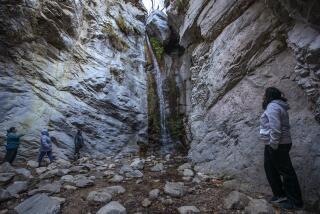Hoping the wonders never cease
- Share via
In a way, the structures were just waiting for this. They passed centuries in glorious esteem, sheltering kings from time to time, inspiring postcard photographers. Think of the vaguely disquieting statues at Easter Island, the luminous marble of the Taj Mahal, the stately Athenian Acropolis and the intimidatingly vast Great Wall of China.
They’re beyond landmarks. Many are official World Heritage Sites, recognized both as lovely and significant by the United Nations. Still, there’s something missing, a sense of incomplete acknowledgment.
It’s this, says Swiss-born adventurer-filmmaker-entrepreneur Bernard Weber: They’re wonderful, and despite the U.N.’s stamp of approval on so many, no one has formally recognized them with the exclusive superlatives he thinks they deserve.
In 2000 he started a foundation to do just that and is now a year away from realizing his dream of proclaiming the new Seven Wonders of the World.
His effort has grown beyond a single globetrotting European entrepreneur starting a website (www.n7w.com). It has become a full-fledged pro-monument movement involving engineers, academics, architects and former government functionaries, as well as 19 million others with three things in common: telephones, a yearning to vote on something obscure and an interest in some particular place on Earth.
Over the last few years, voters nominated a number of man-made sites, and the 77 top vote-getters advanced. They were narrowed to 21 in January by a panel of seven world-famous architects. Results will be announced in 2007, and if you’ve begun to spot the numerical symbolism, you’ve got the idea.
Since Philon of Byzantium named the original Seven Wonders of the World in 200 BC, the Western world has relegated them to an awed mental pedestal -- and then promptly forgot what was on the list. (Name them now without skipping down. Try it.) In those centuries, astonishingly, six of them vanished.
Still with us are the Pyramids at Giza. And, believes Weber -- the sort of visionary explorer undaunted by skepticism -- a powerful need to name a New Seven.
The only remaining U.S. site in the top 21 is the Statue of Liberty -- though the Golden Gate Bridge, Empire State Building and Mt. Rushmore made the list of 77 finalists.
The last list of Seven Wonders was decidedly Mediterranean-centric. And, at 2,000 years old, is getting a little dated.
Earthquakes leveled the Lighthouse of Alexandria. The Hanging Gardens of Babylon may never have existed. Crusading Maltese knights purloined blocks from the Mausoleum of Halicarnassus to build a fortress.
Other Wonders met more elaborate fates. The Colossus of Rhodes was felled by earthquake, left prone by oracle’s decree and hauled off on mules by invading Arab merchants. A disaffected Ephesian burned the Temple of Artemis, after which it was razed by Goths.
Caligula tried to appropriate the Statue of Zeus, and broke it. A Roman successor closed its temple, which later suffered earthquakes, landslides and fire.
“Let’s face it,” he said. “There’s so much destruction and negative things in the world, and I think all of these buildings are testimony of what human beings can achieve by being creative and constructive.”
Weber’s starting place was the United Nations Educational, Scientific and Cultural Organization World Heritage Center in Paris, to see if it had been tried.
Through various means, UNESCO has a $15-million annual budget to catalog and help preserve 184 fantastic natural and architectural sites. After a brief consultation, in which he was told nobody had, Weber moved on to form his own group, said the filmmaker and UNESCO spokeswoman Gina Doubleday.
It’s not the first time something of the kind has been attempted. There have been lists of Forgotten Wonders, Modern Wonders, Natural Wonders, Travel Wonders -- even a Pennsylvania gift shop called Wonders of the World. But since the U.N.’s efforts, Weber’s push is one of the more formal efforts to name and publicize a new list of seven, and it carries a modicum of financial backing.
Will anyone remember them in seven years? Who knows, organizers say. But the attention can hardly hurt the sites, and any money raised by the growing promotional effort could possibly fund their upkeep.
Half the income from the project will be earmarked to protect the final picks and other remarkable edifices, Weber said. A key point considering what happened to the previous seven.
The voting is open to anyone but is done by phone. Go to the website for instructions. Among the other finalists are the Eiffel Tower in Paris, the Pyramids of Giza in Egypt, the Colosseum in Rome, the Kiyomizu Temple in Kyoto, the Acropolis in Athens, Christ the Redeemer statue in Rio de Janeiro, the Great Wall of China, the Hagia Sophia in Istanbul, Stonehenge in Britain and Machu Picchu in Peru.
More to Read
Sign up for The Wild
We’ll help you find the best places to hike, bike and run, as well as the perfect silent spots for meditation and yoga.
You may occasionally receive promotional content from the Los Angeles Times.






